Sexing sounds, and strategies for mates and rivals
I remember reading a beautiful introduction to bird sound in The handbook of birds of the world 6 by Baptista & Kroodsma (2001), when suddenly I learnt that female Alpine Accentors P collaris sing to attract males. I had recorded the song of this species in the French Pyrenees and not imagined that it was anything other than a male. Later, on recounting the story to veteran Dutch birder, Gerald Oreel, he said, “you do realise Dunnock is the same?”. It is always easy to disregard female sounds, and most of the time it is assumed that a singing bird is a male. However, as research continues, more and more female songs are being discovered. In addition, the repertoires of many species include calls that are exclusive to one sex or the other.
Ducks are not only an excellent example of one of the more sexually dimorphic groups in plumage but also in sounds, with drakes generally having the more ‘colourful’ and exotic vocal displays. One of my regular Poole bird pub companions, Shaun Robson, is a wise commentator on all aspects of my quest to understand bird sounds. He is sometimes pushed to the limits of his patience with my constant questions. This was best summed up when a calling female Mallard flew past and I asked if he had ever thought about the sounds made by female American Black Duck A rubripes. “I don’t know and I don’t want to know” was the sanguine reply. Let’s start with Shaun’s male and female Mallard and how to tell them apart. Although Mallard have a variety of different calls, males and females always have quite different sounding voices (CD2-17). One of the main calls of male Mallard is often preceded by a quiet ticking sound. Females have much louder calls; their sound is a much fuller and rounder quacking, using a far wider range of frequencies. American Black Duck’s corresponding sounds aren’t so different so Shaun may well have made the right decision.
CD2-17a (0:00–0:22): Mallard Anas platyrhynchos Weerribben, Overijssel, Netherlands, 28 March 2003. Typical calls of a male as it swam past the microphone at night. Each call is preceded by a quiet clicking sound. Background: Greylag Goose Anser anser and Greater White-fronted Goose A albifrons. 04.010.MR.05545.01
CD2-17b (0:23–0:51): Mallard Anas platyrhynchos Kollumerpomp, Friesland, Netherlands, 01:13, 17 March 2003. Typical quacking of a female; a much quieter male can be heard after about her 10th quack. Background: Eurasian Coot Fulica atra. 03.003.AB.13859.00
Hamish, Shaun and I make up a winning local bird race team in Dorset, aided and abetted by ace bird race driver Nick Hopper. A good team needs a mix of skills and if you want quacking ducks identified in the dark, Nick is your man. Nick is able to pick off female Common Teal A crecca by sound at 05:00 am on a winter’s morning, then drive at such speed, that as he advises Shaun on the fine detail of identifying duck sound, Shaun’s too busy holding on to comment. Try for yourself, pop this CD in the car stereo, put your foot down and listen to a female Common Teal recorded by Killian on a spring night in Lapland (CD2-18). Her quacks are shorter, higher-pitched and weaker than the corresponding quacks of female Mallard. After about 12 seconds a male can be heard, giving very different short whistled calls as he approaches and settles on the water; the female becomes excited and calls more loudly.
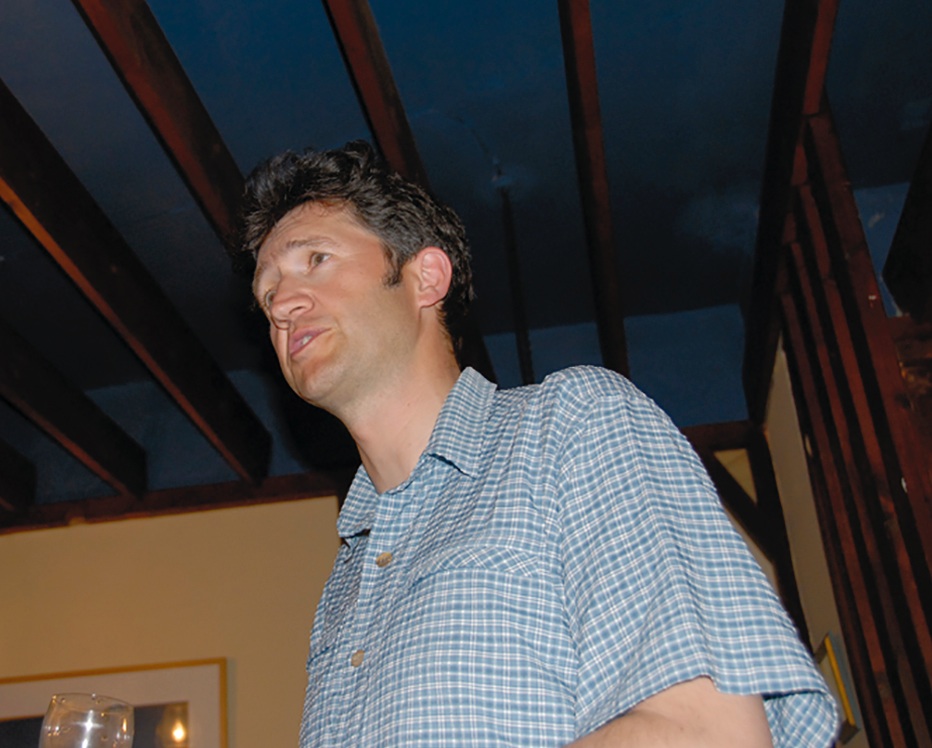
Shaun Robson at Poole, Dorset, 20 April 2006 (Arnoud B van den Berg)
CD2-18: Common Teal Anas crecca Lake Toranki, Kuusamo, Lapland, Finland, 01:30, 16 May 2003. Quiet quacking of a female, becoming louder when a male arrives giving short whistled calls. Background: Black Grouse Tetrao tetrix, Red-necked Grebe Podiceps grisegena, Wood Sandpiper Tringa glareola, Song Thrush Turdus philomelos and Redwing T iliacus. 03.006.KM.05215.11
Listen to two pairs of King Eiders S spectabilis as they swam past a microphone Magnus had laid beside a tundra pool in the Lena delta, Siberia (CD2-19). The females are only responsible for the rather nondescript gog-gog-gog sounds, while the males produce a range of beautiful crooning sounds that differ from those of Common Eider in that they are delivered more rapidly and with a slight vibrato.
CD2-19: King Eider Somateria spectabilis Nizhny Bobrowsky island, Lena delta, Yakutia, Russia, 17:00, 25 June 2004. Two pairs swim past the microphone on a long, narrow pool on the tundra. The more expressive sounds are the males, while the females give gog-gog-gog calls hardly differing from female Common Eider calls. Background: Temminck’s Stint Calidris temminckii and Lapland Longspur Calcarius lapponicus. 04.032.MR.20245.01
Ruddy Ducks Oxyura jamaicensis have a most entertaining display, and these were recorded communally displaying on a lake in the prairies in Alberta, Canada, among a host of other fantastic singing and displaying birds (CD2-20). The continuous high peeping sound heard more or less throughout the recording (about three or four per second) is a female Ruddy. Meanwhile, males can be heard giving two different displays. A popping rattle always accompanied by a splash is part of a display called the ringing rush, best heard after seven seconds. Incredibly, the popping is produced by the male’s feet hitting the water. The other is called the bubbling display which you can hear from the start throughout the recording.
CD2-20: Ruddy Duck Oxyura jamaicensis Frank Lake, Alberta, Canada, 08:26, 9 June 2003. Male bubbling displays (each ending with a quiet burp) from start, and ringing rush (popping rattle with splash) at for instance 0:07, with continuous peeping of females. Background: American Bittern Botaurus lentiginosus, American Coot Fulica americana, Franklin’s Gull Larus pipixcan and Yellow-headed Blackbird Xanthocephalus xanthocephalus. 03.024.AB.11500.00
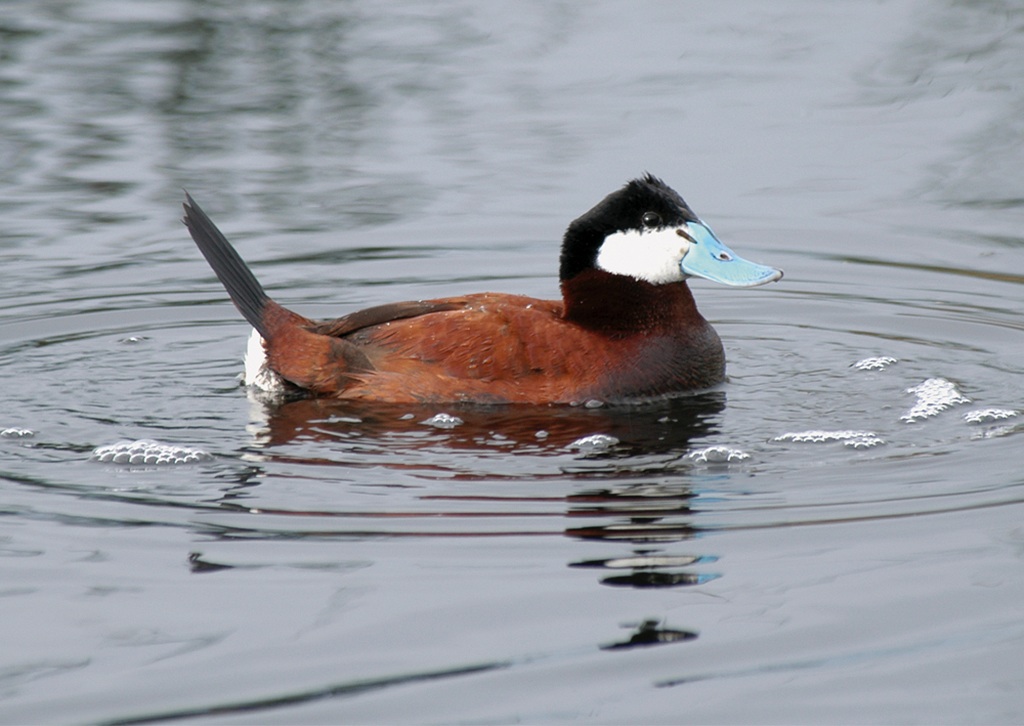
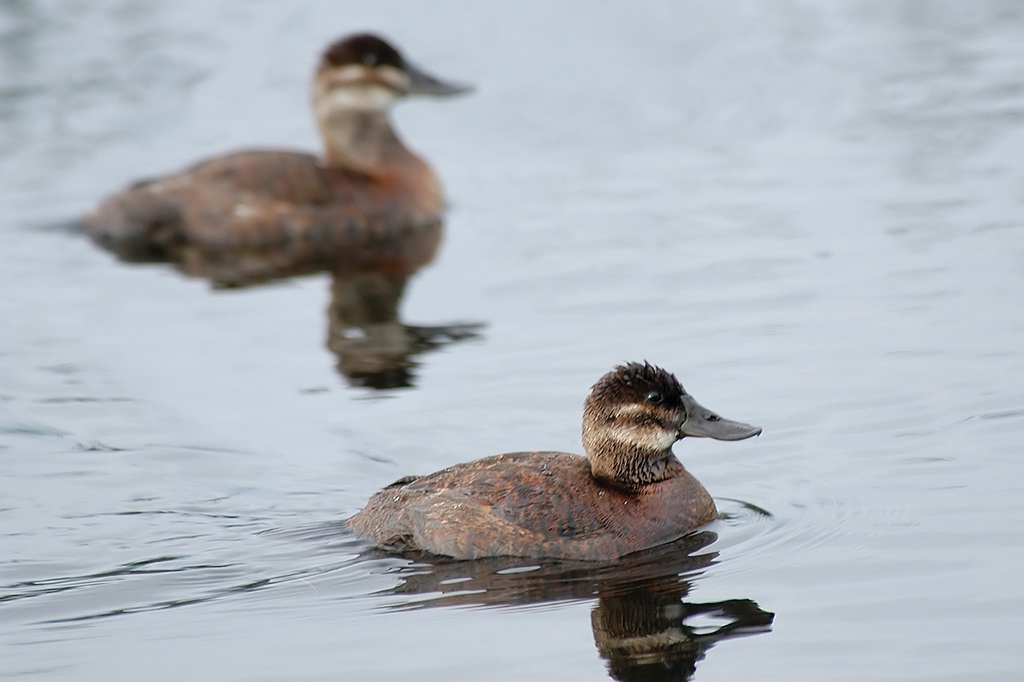
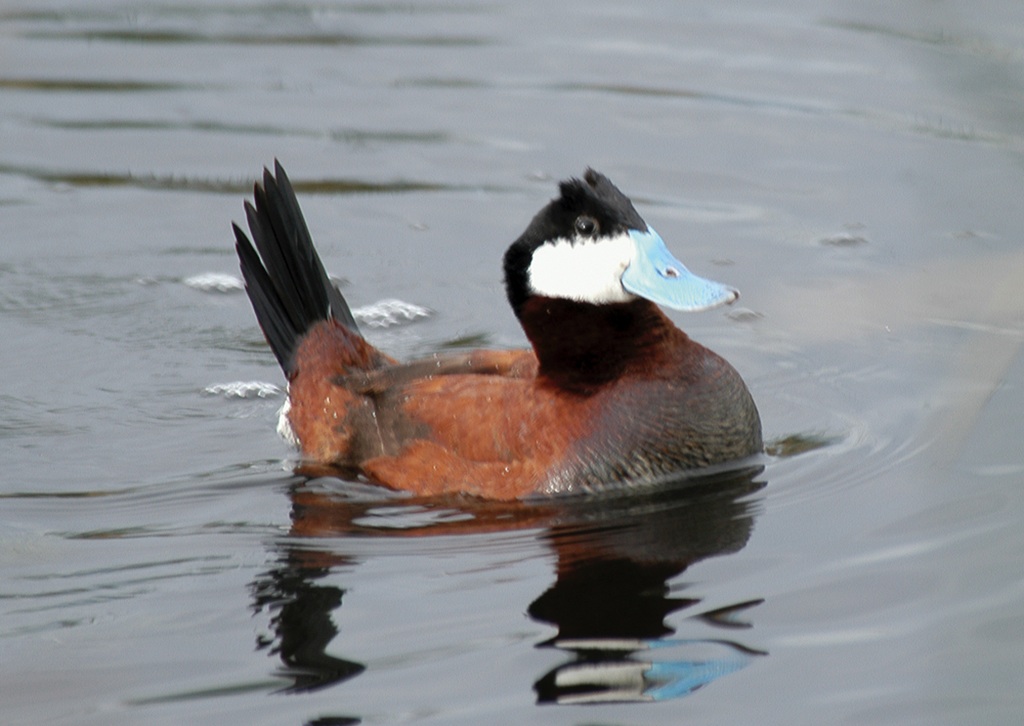
Ruddy Ducks Oxyura jamaicensis, males in display (right) and females (left), Frank Lake, Alberta, Canada, 9 June 2003 (Arnoud B van den Berg). Same birds as on CD2-20.
It wasn’t easy to get Magnus enthusiastic about sexing bird sounds until he found a new example in Siberia in June 2004. On the breeding grounds, Pectoral Sandpipers C melanotos are easily sexed; the males are larger, and have an inflatable throat sac that they use to produce their incredible booming song. In this display flight (CD2-21) a male is chasing a female and the high, metallic-sounding krrr krrr calls heard from the start are produced by the female while the deep poo-poo-poo-poo… song is produced by a male, using its throat sac as a resonator. A second male joins the chase at 0:19, making deep churring sounds and male-type flight calls. During the breeding season, the most common calls of males and females, used in all kinds of flight situations including when flushed, can be separated easily (CD2-22). Magnus was hooked once he recorded two migrant adult Pectorals together in the Netherlands in mid-July, a few weeks after his Siberian trip, and found that they could still be sexed when they gave the deeper, more snipe-like male calls.
CD2-21: Pectoral Sandpiper Calidris melanotos Lena delta, Yakutia, Russia, 14 June 2004. Display flight of two males and a female. Background: Little Stint C minuta and Curlew Sandpiper C ferruginea. 04.028.MR.05546.22
CD2-22a: Pectoral Sandpiper Calidris melanotos Lena delta, Yakutia, Russia, 10 June 2004. Two loud snipe-like calls of a male in flight. Background: Curlew Sandpiper C ferruginea. 04.026.MR.13638.01
CD2-22b: Pectoral Sandpiper Calidris melanotos Safety Sound, Seward Peninsula, Alaska, USA, 19:45, 31 May 2004. Call of a flushed female. Background: Lapland Longspur Calcarius lapponicus. 04.011.AB.04654.02
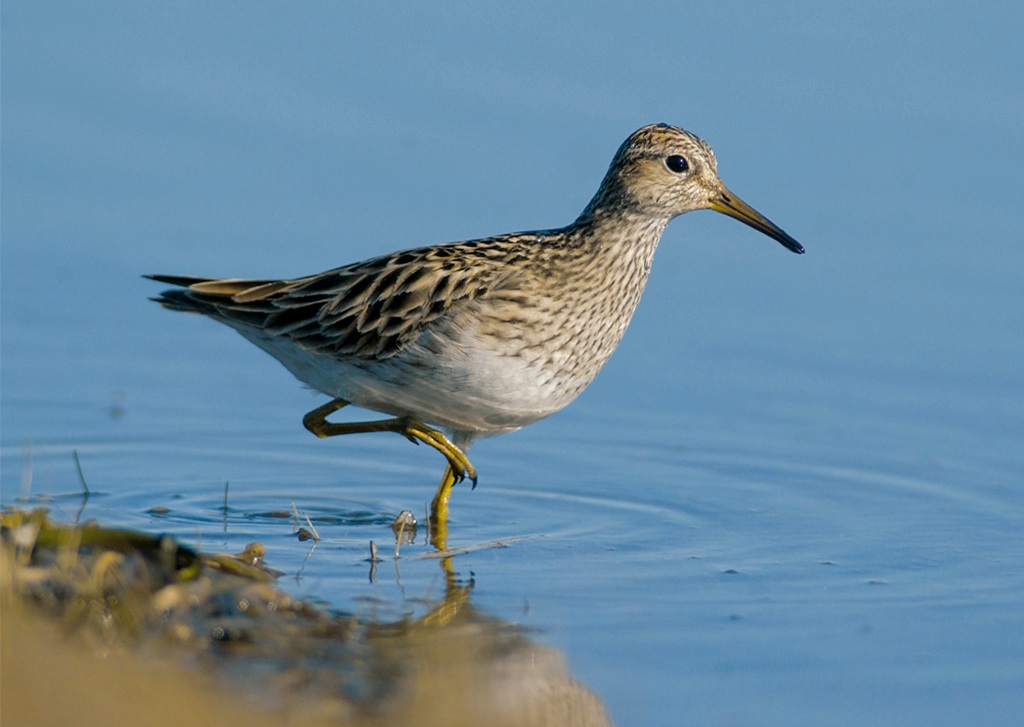
Pectoral Sandpiper Calidris melanotos, female, Safety Sound, Seward Peninsula, Alaska, USA, 31 May 2004 (René Pop). Same bird as on CD2-22b.
As you’ve probably realised Magnus has been something of a work horse throughout this project and sometimes when we started The Sound Approach, we debated skipping certain species like the shearwaters, because nobody ever hears them, and Magnus’s time and our money probably didn’t allow. Nonetheless we couldn’t resist and yet again we sent in Magnus, this time to visit a Cory’s Shearwater Calonectris borealis colony on Tenerife, Canary Islands. When I heard the recordings he made in Barranco del Infierno, or ‘canyon of hell’, I was glad if a little jealous (CD2-23). He had to wait what seemed a very long time after sunset, and had been on the point of leaving when the first birds started to call. After a while, the amazing acoustics of the very steep-sided canyon were echoing to the sound of shearwaters swarming in the darkness. Shearwaters call to form and maintain pair bonds, having to identify their male or female in the dark. Male and female calls are very easy to tell apart (Ristow & Wink 1979). As with most shearwaters, female Cory’s have deeper, coarser voices than males. You can hear one passing close by several times, coming closest at 0:28.
CD2-23: Cory’s Shearwater Calonectris borealis Barranco del Infierno, Tenerife, Canary Islands, 8 April 2001. Shearwaters calling as they fly around in a narrow canyon a couple of hours after sunset. 01.009.MR.00635.00
Sexing Grant’s (Band-rumped) Storm Petrels Oceanodroma vocally was first described by Paul James & Hugh Robertson (1985). They described three calls ‘high, burrow and flight’. As is the way with such descriptions they become embarrassing, and so it is here with ‘flight’ being heard both in flight and in the burrow (CD2-24). The ‘high’ call, a high squealing heard at the start of the recording, is the same in both sexes. In the other two calls, the ‘burrow’ call and the ‘chatter’ call, males and females can be told apart. As in Cory’s Shearwater, females have the coarser, less melodious voice, and in Grant’s Storm Petrel this shows in a sonagram as a solid dark vertical smudge over their frequency range, while males have a more melodious voice, showing clear harmonic bands. The first ‘flight’ calls to be heard clearly, at 0:19 and 0:28, are of a female. A male’s ‘burrow’ calls are heard throughout the recording until 0:53 seconds, at which point you can hear a nine second sequence of ‘flight’ calls of a male and two females calling to each other.
CD2-24: Grant’s (Band-rumped) Storm Petrel Oceanodroma (cold-season) Farilhão Grande, Berlengas islands, Leiria, Portugal, around midnight, 22 September 2003. Calls by two or three males and three females. These birds belong to the cold-season breeding population of the ‘Band-rumped storm petrel group’ (cf Robb et al 2008). In some parts of the North Atlantic, a hot-season population with different biometrics uses the same burrows in late spring and summer (Sangster 1999). The two populations also sound different, and everything points towards them being separate species, but they have yet to be described formally. 03.036.MR.10333a.01
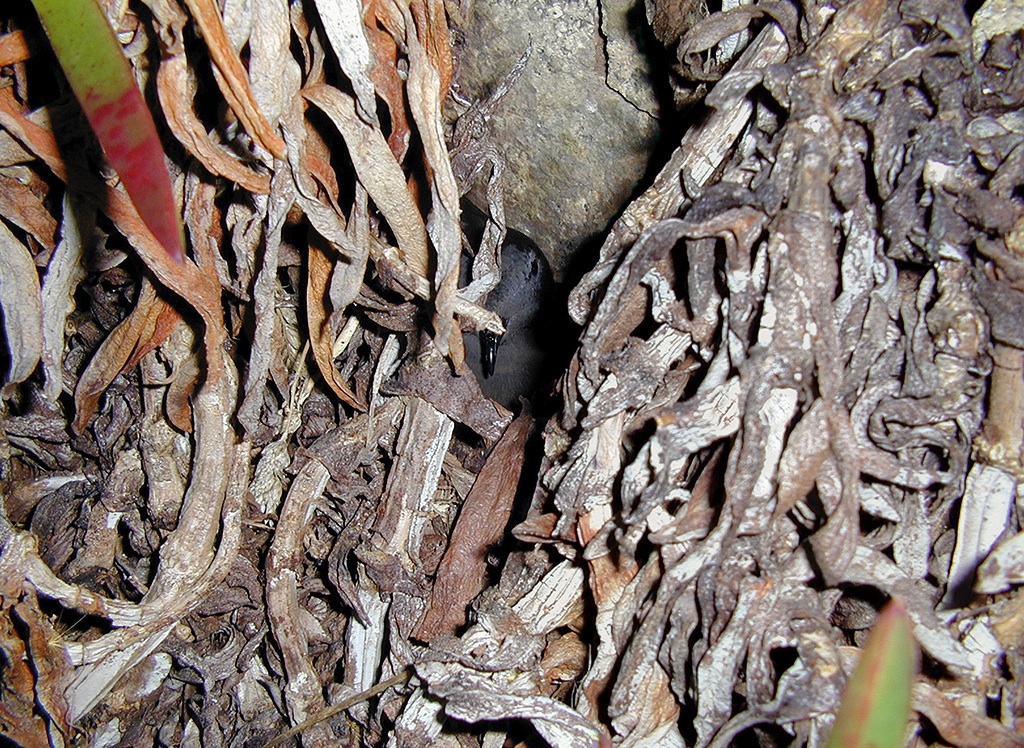
Grant’s (Band-rumped) Storm Petrel Oceanodroma (cold-season), Farilhão Grande, Berlengas, Leiria, Portugal, 22 September 2003 (Magnus Robb). At same site as the birds in CD2-24.
Having done a lot of my spring birding in Mallorca I had heard European Scops Owls Otus scops many times but only learnt that they duet while searching for a Spotted Crake P porzana with a Belgian bird tour leader, who pointed it out. In duetting song the female responds to the male with a slightly higher-pitched song, often slightly ‘out of sync’ with the male. In this recording (CD2-25), listen to a pair performing a duet.
CD2-25: European Scops Owl Otus scops Pollença, Mallorca, Spain, 06:00, 9 April 2002. Song duet, with male being louder, lower-pitched bird and female weaker (or more distant) and higher-pitched. Background: other scops owls. 02.008.MC.01842.02
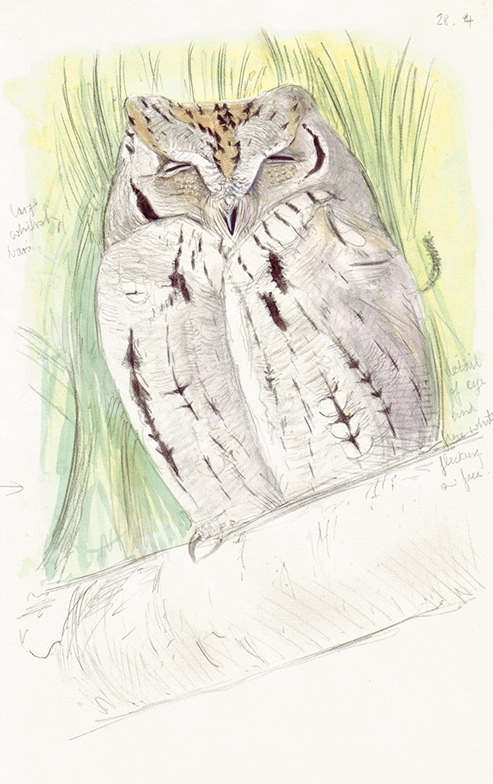
European Scops Owl Otus scops, Mallorca, Spain, 28 April 1986 (Killian Mullarney)
Common Swifts have calls that can also be sexed. One of their most characteristic sounds is duetting, heard most often at dusk, in which a rapid series of short screams is given by the two in alternation (CD2-26). Erich Kaiser (1997) discovered that in these duets, the higher swee is always given by a female and the lower ree is always a male. In our recordings, a similar alternation of high and low screams suggests that the same rule applies with duetting Pallid Swift (CD2-27). The sounds are differently inflected from those of Common Swift.
CD2-26: Common Swift Apus apus Ishak Pasha palace, Agrı, Turkey, 5 June 2002. Duetting at dusk; a pair already in their nest respond to another swift that is still airborne. Background: visitors to the ruined palace. 02.032.MR.12443.01
CD2-27: Pallid Swift Apus pallidus Islote de Benidorm, País Valenciano, Spain, dusk, 7 August 2002. At least two duetting pairs calling from their nests at dusk. Background: Yellow-legged Gull Larus michahellis. 02.038.MR.00921.00
Ultra-crystallised songs
The song that the male Collared Flycatcher F albicollis uses to attract a mate to a nest hole is not very exciting to you and I, but Magnus loved it (CD2-28). Having heard it I sort of dismissed it as just a subsong and he exploded. “It is not just a subsong. It’s highly motivated, sexually charged and ultra-crystallised.”
CD2-28: Collared Flycatcher Ficedula albicollis Białowieza forest, Podłaskie, Poland, 07:45, 6 May 2005. Quiet, imitative song of a first-summer male trying three times to tempt a female into a nest cavity he has selected. Background: Common Chiffchaff Phylloscopus collybita, Wood Warbler P sibilatrix, Great Tit Parus major and Common Chaffinch Fringilla coelebs. 05.007.MR.02045.02
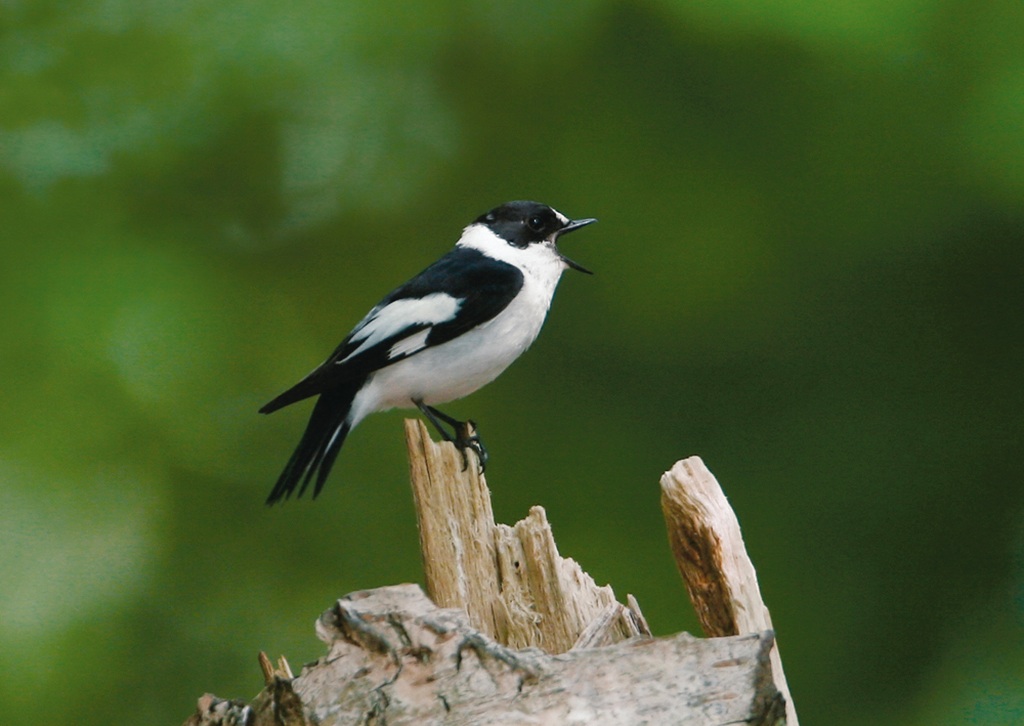
Collared Flycatcher Ficedula albicollis, adult male, Noord-Ginkel, Ede, Gelderland, Netherlands, 11 June 2006 (Roland Jansen)
Males of many species reserve their finest songs for the time when their seductive powers need to be at their height – immediately prior to copulation. Listen to what happens when this Western Orphean Warbler S hortensis, which has been patiently singing its simple, territorial song for the first 15 seconds, sees a female nearby (CD2-29). Suddenly he changes to a quieter but much longer and more intricately detailed one as he pursues her.
CD2-29: Western Orphean Warbler Sylvia hortensis Torrejón El Rubio, Tahéna, Extremadura, Spain, 12:00, 27 April 2004. Simple song for 15 sec, then complex courtship song as a female arrives. Background: European Blue Tit Cyanistes caeruleus, Great Tit Parus major and Corn Bunting Emberiza calandra. 04.010.MC.04345.12
This kind of ecstatic songs are also used by some species in other highly charged situations, such as territorial disputes. Listen to these three male Desert Wheatears Oenanthe deserti recorded in Tunisia (CD2-30), singing with unusual virtuosity in a territorial conflict. The songs heard at the end of the recording are closer to the normal territory-marking song. An example from closer to home can be heard in a recording of Common Blackbird ecstatic song (CD2-31), heard during a territorial encounter between two males. One sang this weird song, displaying to the other with writhing threat postures, while the other adopted a submissive posture giving srrr ‘flight’ calls, perhaps as a sign of submission.
CD2-30: Desert Wheatear Oenanthe deserti Douz, Kebili, Tunisia, 11:22, 6 May 2005 Ecstatic songs of three males in dispute at their territorial borders in a sand desert. 05.008.AB.12014.01
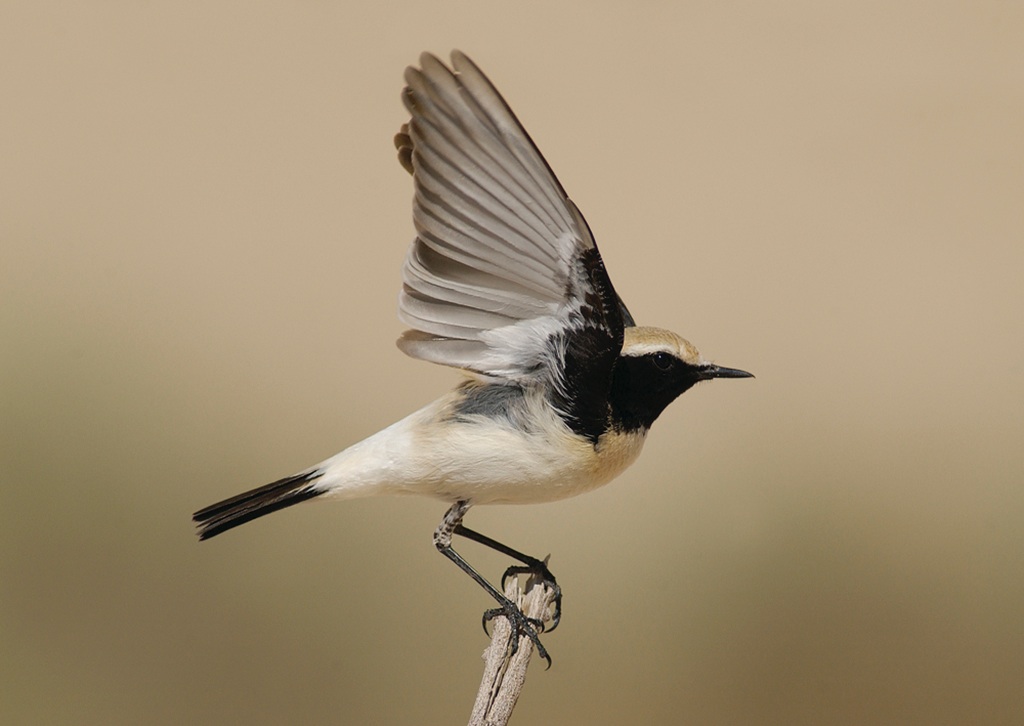
Desert Wheatear Oenanthe deserti, male, Douz, Kebili, Tunisia, 6 May 2005 (René Pop). One of three males singing in dispute on CD2-30.
CD2-31: Common Blackbird Turdus merula Amsterdamse Waterleidingduinen, Noord-Holland, Netherlands, 5 March 2002. Rather strangled-sounding quiet and very detailed song of an adult male threatening another male. Background: Great Spotted Woodpecker Dendrocopos major, Dunnock Prunella modularis and Marsh Tit Poecile palustris. 02.008.MR.11840.01
Having given thought to Magnus’s point of view I now understand that in dismissing these ‘ultra-crystallised’ songs as subsongs we miss the point. I think that as The Sound Approach continues we will find that in many species songs are used in this kind of situation which sound closer to subsong or plastic song because of their greater length, lower volume and more varied nature, often including more mimicry. However, there is nothing ‘plastic’ or undeveloped about them. Rather, they might be seen as an ‘ultra-crystallisation’ of the subsongs some birds spend so long in the bushes practicising until the bird’s singing skills have reached their highest level of perfection.
So, the mature song repertoire of adults goes from powerful but stereotyped territorial songs to intricately crystallised and intense pre-copulation songs. Song may be used to attract a mate, and some species use song only for this. Catchpole (Catchpole & Slater 1995) discovered that Sedge Warblers stop singing once paired and may only sing again when the female is on eggs in an attempt to attract a second female. Starlings are the same, and these birds, which are so vocal for much of the year, are often quiet in the peak spring period for song in other species. On the other hand, song may be used primarily to proclaim ownership of a territory, or advertising and territorial songs may be combined.
Great Reed Warbler is a rarity in Dorset, although one took up residence ‘just up the road’ one spring and sang for three weeks. The song of an unpaired male has a steady, forceful beat like two carpenters taking it in turns to hammer, a big hammer creating low-pitched dur dur dur sounds immediately followed by a small one making higher-pitched dee dee dee sounds. If it impersonates anything, the feeling you get is that it likes frog and toad sounds, as this is what you could mistake it for in its lower ranges. Song length is also an interesting aspect here, as Catchpole (1983) has found that Great Reed begins the breeding season by singing long varied songs to attract a mate (the more varied the songs the quicker a mate appears), and simplifies this once a pair has been formed, then tending to sing short song phrases. Compare long unpaired song (CD2-32) and short paired song of this species (CD2-33) for yourself. The latter are so simple they consist of little more than a phrase of low dur notes followed by a phrase of high dee notes, with slight variations in rhythm each time.
CD2-32: Great Reed Warbler Acrocephalus arundinaceus Parc Natural S’Albufera, Mallorca, Spain, 10:15, 19 April 2000. Long songs of a male that arrived a day or two before the recording was made, and was presumably still unpaired. Background: Cetti’s Warbler Cettia cetti and another Great Reed Warbler in the distance. 00.007.MC.00900.20
CD2-33: Great Reed Warbler Acrocephalus arundinaceus Reeuwijkse Plassen, Zuid-Holland, Netherlands, 07:42, 14 May 2000. Short songs of a male that was presumably already paired. Background: Black-tailed Godwit Limosa limosa, Black-headed Gull Chroicocephalus ridibundus, Eurasian Collared Dove Streptopelia decaocto, Sedge Warbler A schoenobaenus and Eurasian Wren Troglodytes troglodytes. 03.013.AB.00007.01
Song matching: how birds cheat to avoid bringing up another bird’s young
Consider the classic, wholesome image of a songbird, singing its heart out to welcome the spring with purity and joy. Science has uncovered a far sleazier truth: singing is actually a kind of poker game where the players are constantly gambling and bluffing. The winners can have their wicked way with another player’s ‘bird’, while the losers bring up another player’s young, or in the worst case they die.
One of the most exciting writers about this subject is Eugene Morton, who summed up the singing behaviour of territorial birds as “an evolutionary arms race”. The competition starts in spring when songbirds stake out their territories, singing from song posts, or earlier in a non-migratory species. Adults occupy the best territories first, and then when first-year males arrive they fill any gaps. Young birds copy the song phrases of older ones as their songs crystallise; adults already present are their tutors for this last phase of their education. In some species such as Common Blackbirds and Great Tits, older birds may also learn some new sounds, perhaps emulating some phrase by a more successful neighbour.
Degradation, as we have heard, is caused by reverberation and reflections from foliage, rocks and other obstacles however small, and it tends to increase with distance from the sound source. This is the principle means by which songbirds judge the distance to their rivals, and it is one reason why song matching is so important. Morton (1982) explains in his ranging hypothesis: “if the listener has learned to sing his neighbors’ songs, he can match this undegraded song stored in his brain to the song he hears. Therefore, if the listener has learned neighbors’ songs, he is able to determine more accurately his distance from the singer and therefore challenge the singer if it is near and ignore the singer if it is far away”. Morton (1996) later wrote: “A loud song, detectable over a long distance because of high source amplitude, may still be ignored by listening birds if it has become degraded.” Similarly, a recording played as a lure by birders may be ignored, no matter how loudly it is played, if crucial parts of the sound are degraded due to having been recorded from too great a distance, or with poor equipment.
Bearing this in mind, it becomes clear why birds always select their song perches so carefully. Their aim is to avoid acoustic degradation and project as far as they can, trying to sound closer than they really are to their neighbours, and increasing the amount of territory they can seem to be present in at any one time. At the same time, optimum sound projection allows them to reach a maximum number of potential mates in the general area. It is cleverer to sing from the ideal perch or trajectory than to spend more energy singing louder. Everything about the choice of perch has this question of degradation in mind and conversely, when still at the subsong stage, singers opt for dense foliage to encourage degradation in order to prevent any aggressive response.
The rather Victorian idea of a male bird singing from his perch, while his mate tends to their young, has been put in perspective by much recent DNA research. This has established that in a surprisingly large number of cases (up to 50% in some species), the young that both parents invest so much energy in to bringing up were actually fathered by a male from another pair. Further analysis has shown that in many songbird species, females actively seek copulations with other males, often ones with richer song repertoires (better chat-up lines), while maintaining the pair bond with their current mate. The picture is rather more complex and intriguing than it seemed. So once mated, a male sings to aggravate other males and deter them from fertilising his mate. Meanwhile she is deciding whether he or another male will fertilise her, so the male also has to impress her enough with his song to retain her loyalty. But he is also an opportunist; given half a chance, he will fertilise any other female that his song also succeeds in attracting.
Staicer, Spector & Horn (1996) sum up the circumstances in which they see most songbirds extremely well: “The social relationships between territorial birds can be visualised as a complex and dynamic web, manifested in territory ownership, pair-bonds, and genetic offspring. Territory edges and contents (e.g., mates, nest sites, and young) may change from day to day… When a neighbour disappears or a new bird arrives, the remaining birds shift their territory boundaries; a mate’s presence, reproductive state, and behavior may also change daily and clearly influence the behavior of a territorial bird… For example, when a female selects a nest site peripheral to her mate’s territory, he typically enlarges the territory to encompass the area surrounding the nest.” They point out that nest predation is very high in some species and as a consequence, abandonment of the territory is quite likely. When a territory becomes vacant, the neighbours will try to take it over within a few days or even hours. Unmated first-year males will also float around a group of territories waiting for this, or hoping for the death of a male so they can take its place or insert a new territory in that range. Unpaired males will also take up residence on the edge of a series of territories, often in less than optimal habitat, and sing throughout the summer.